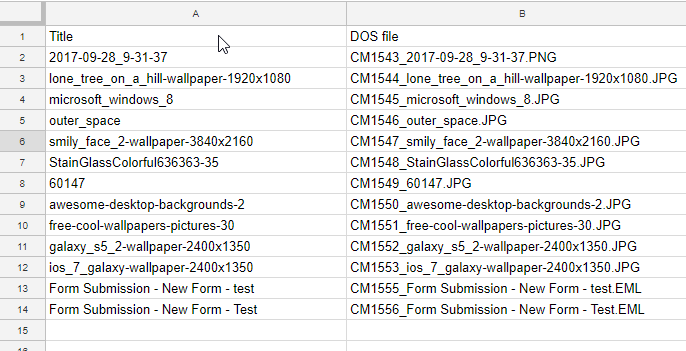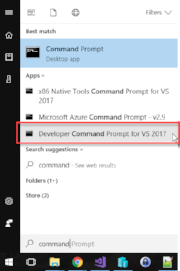Export Mania 2017 - DataPort
Someone asked a vague question over on the forum about exporting electronic documents. Since I haven't done a post about exporting yet, I thought this would be a good topic to cover. The OP wasn't specific about how to go about exporting so we'll cover them all over the coming posts!
Let's define a few requirements:
- There will be a file exported that include's meta-data for the given record(s)
- There will be a folder created to contain the electronic documents for the given record(s)
- The names of the electronic documents shall be the record numbers and not the record titles
Let's see how to accomplish this with DataPort...
Out-of-the-box DataPort
I can use the out-of-the-box Tab Delimited formatter to craft a DataPort project using the settings below.
In the settings section I can specify where the documents are be exported. Then I scroll down to pick my saved search.
Lastly, I pick the fields I want. I must include the "DOS file" to get the electronic attachments. So for now I'll include the title and DOS file.
If I save and execute this project I get a meta-data file like this one...
And a set of electronic documents like these...
The forum post asked how these file names could be in record number format. The existing format is a combination of the dataset ID, the URI, an underscore, and the suggested file name. If this is as far as I go then I cannot meet the requirement.
So purely out-of-the-box is insufficient! :(
Out-of-the-box DataPort with Powershell
I think a quick solution could be to directly rename the files exported. Unfortunately my current export lacks enough meta-data to accomplish the task though. The file name doesn't include the record number. Nor does the meta-data file.
But if I add "Expanded number" as a field, I can then directly manipulate the results.
Now my meta-data file looks like this...
Now that I have the meta-data I need I can write a powershell script to accomplish my tasks. The script doesn't actually need to connect into CM at all (though it's probably best if I looked up the captions for the relevant).
The script does need to do the following though:
- Open the meta-data file
- Iterate each record in the file
- Rename the existing file on disk
- Update the resulting row of meta-data to reflect the new name
- Save the meta-data file back.
A quick and dirty conversion of these requirements into code yields the following:
$metadataFile = "C:\DataPort\Export\Out-of-the-box Electronic Export\records.txt" $subFolder = "C:\DataPort\Export\Out-of-the-box Electronic Export\Documents\" $metaData = Get-Content -Path $metadataFile | ConvertFrom-Csv -Delimiter "`t" for ( $i = 0; $i -le $metaData.Length; $i++ ) { $recordNumber = $metaData[$i]."Expanded Number" $existingFileName = $metaData[$i]."DOS file" $existingFilePath = [System.IO.Path]::Combine($subFolder, $existingFileName) $newFileName = ($recordNumber + [System.IO.Path]::GetExtension($existingFileName)) $newFilePath = [System.IO.Path]::Combine($subFolder, $newFileName) if ( ![String]::IsNullOrWhiteSpace($existingFileName) -and (Test-Path $existingFilePath) -and (Test-Path $newFilePath) -eq $false ) { if ( (Test-Path $newFilePath) ) { Remove-Item -Path $newFilePath } Move-Item -Path $existingFilePath -Destination $newFilePath $metaData[$i].'DOS file' = $newFileName } } $metaData | ConvertTo-Csv -Delimiter "`t" -NoTypeInformation | Out-File -FilePath $metadataFile
After I run that script on my DataPort results, I get this CSV file...
And my electronic documents are named correctly...
So with a little creative powershell I can achieve the result, but it's a two step process. I must remember to execute this after I execute my export. Granted, I could actually call the export process at the top of the powershell and then not mess with DataPort directly.
This still seems a bit of a hack to get my results. Maybe creating a new DataPort Export Formatter is easy?
Custom DataPort Export Formatter
The out-of-the-box Tab delimited DataPort formatter works well. I don't even need to re-create it! I just need to be creative.
So my first step is to create a new visual studio class library that contains one class based on the IExportDataFormatter interface.
namespace CMRamble.DataPort.Export { public class NumberedFileName : IExportDataFormatter { } }
If I use the Quick Action to implement the interface, it gives me all my required members and methods. The code below shows what it gives me...
public string KwikSelectCaption => throw new NotImplementedException(); public OriginType OriginType => throw new NotImplementedException(); public string Browse(Form parentForm, string searchPrefix, Point suggestedBrowseUILocation, Dictionary<AdditionalDataKeys, DescriptiveData> additionalData) { throw new NotImplementedException(); } public void Dispose() { throw new NotImplementedException(); } public void EndExport(Dictionary<AdditionalDataKeys, DescriptiveData> additionalData) { throw new NotImplementedException(); } public void ExportCompleted(ProcessStatistics stats, Dictionary<AdditionalDataKeys, DescriptiveData> additionalData) { throw new NotImplementedException(); } public void ExportNextItem(List<ExportItem> items, Dictionary<AdditionalDataKeys, DescriptiveData> additionalData) { throw new NotImplementedException(); } public string GetFormatterInfo(Dictionary<AdditionalDataKeys, DescriptiveData> additionalData) { throw new NotImplementedException(); } public void StartExport(string exportPath, bool overWriteIfExists, DataPortConfig.SupportedBaseObjectTypes objectType, string TRIMVersionInfo, string[] headerCaptions) { throw new NotImplementedException(); } public string Validate(Form parentForm, string connectionStringToValidate, Dictionary<AdditionalDataKeys, DescriptiveData> additionalData) { throw new NotImplementedException(); }
Now I don't know how the out-of-the-box tab formatter works, and to be honest I don't care how it does what it does. I just want to leverage it! So I'm going to create a static, readonly variable to hold an instance of the out-of-the-box formatter. Then I force all these members and methods to use the out-of-the-box formatter. It makes my previous code now look like this....
private static readonly ExportDataFormatterTab tab = new ExportDataFormatterTab(); public string KwikSelectCaption => tab.KwikSelectCaption; public OriginType OriginType => tab.OriginType; public string Browse(Form parentForm, string searchPrefix, Point suggestedBrowseUILocation, Dictionary<AdditionalDataKeys, DescriptiveData> additionalData) { return tab.Browse(parentForm, searchPrefix, suggestedBrowseUILocation, additionalData); } public void Dispose() { tab.Dispose(); } public void EndExport(Dictionary<AdditionalDataKeys, DescriptiveData> additionalData) { tab.EndExport(additionalData); } public void ExportCompleted(ProcessStatistics stats, Dictionary<AdditionalDataKeys, DescriptiveData> additionalData) { tab.ExportCompleted(stats, additionalData); } public void ExportNextItem(List<ExportItem> items, Dictionary<AdditionalDataKeys, DescriptiveData> additionalData) { tab.ExportNextItem(items, additionalData); } public string GetFormatterInfo(Dictionary<AdditionalDataKeys, DescriptiveData> additionalData) { return tab.GetFormatterInfo(additionalData); } public void StartExport(string exportPath, bool overWriteIfExists, DataPortConfig.SupportedBaseObjectTypes objectType, string TRIMVersionInfo, string[] headerCaptions) { tab.StartExport(exportPath, overWriteIfExists, objectType, TRIMVersionInfo, headerCaptions); } public string Validate(Form parentForm, string connectionStringToValidate, Dictionary<AdditionalDataKeys, DescriptiveData> additionalData) { return tab.Validate(parentForm, connectionStringToValidate, additionalData); }
If I compile this and register it within DataPort, I have a new Export DataFormatter that behaves just like the out-of-the-box formatter (trust me, I tested it). Now what I need to do is to add the logic that renames my files and the corresponding meta-data.
First steps first: I need to store some of the information provided in the StartExport method.
private bool correctExportedFileName = false; private string exportPath; public void StartExport(string exportPath, bool overWriteIfExists, DataPortConfig.SupportedBaseObjectTypes objectType, string TRIMVersionInfo, string[] headerCaptions) { this.exportPath = $"{Path.GetDirectoryName(exportPath)}\\Documents"; var captions = headerCaptions.ToList(); var numberField = captions.FirstOrDefault(x => x.Equals(new EnumItem(AllEnumerations.PropertyIds, (int)PropertyIds.AgendaItemExpandedNumber).Caption)); var fileField = captions.FirstOrDefault(x => x.Equals(new EnumItem(AllEnumerations.PropertyIds, (int)PropertyIds.RecordFilePath).Caption)); if ( numberField != null & fileField != null ) { correctExportedFileName = true; } tab.StartExport(exportPath, overWriteIfExists, objectType, TRIMVersionInfo, headerCaptions); }
Note that in the code above I've had to do a couple of seemingly dodgy things:
- I had to hard-code the name of the subfolder because it's not avialable to me (so weird I can't access the project details)
- I used the AgendaItemExpandedNumber property Id because that's what maps to the record's expanded number (weird, I know)
All that's left to do is to fix the file and meta-data! I do that in the ExportNextItem method. That method is invoked each time an object has been extracted. So that's when I need to do the rename and meta-data correction.
My method becomes:
public void ExportNextItem(List<ExportItem> items, Dictionary<AdditionalDataKeys, DescriptiveData> additionalData) { if ( correctExportedFileName ) { var numberField = items.FirstOrDefault(x => x.ItemCaption.Equals(new EnumItem(AllEnumerations.PropertyIds, (int)PropertyIds.AgendaItemExpandedNumber).Caption)); var fileField = items.FirstOrDefault(x => x.ItemCaption.Equals(new EnumItem(AllEnumerations.PropertyIds, (int)PropertyIds.RecordFilePath).Caption)); if ( numberField != null && fileField != null ) { var originalFileName = Path.Combine(exportPath, fileField.ItemValue); if ( File.Exists(originalFileName) ) { var newFileName = $"{numberField.ItemValue}{System.IO.Path.GetExtension(fileField.ItemValue)}"; var newFilePath = Path.Combine(exportPath, newFileName); if (File.Exists(newFilePath) && File.Exists(originalFileName)) { File.Delete(newFilePath); } File.Move(originalFileName, newFilePath); fileField.ItemValue = newFileName; } } } tab.ExportNextItem(items, additionalData); }
Now if I compile and export, my meta-data file looks exactly the same as the previous method (out-of-the-box with powershell)!
Feel free to try out my DataPort Formatter here.

















